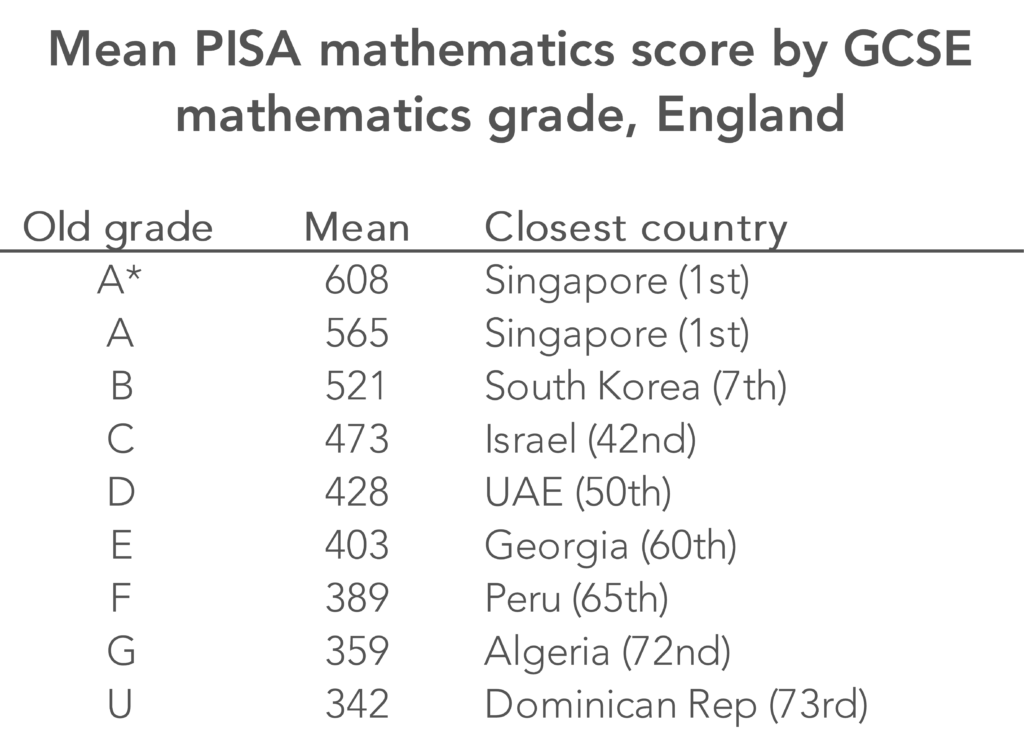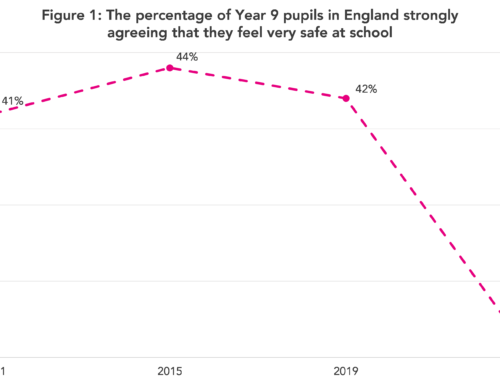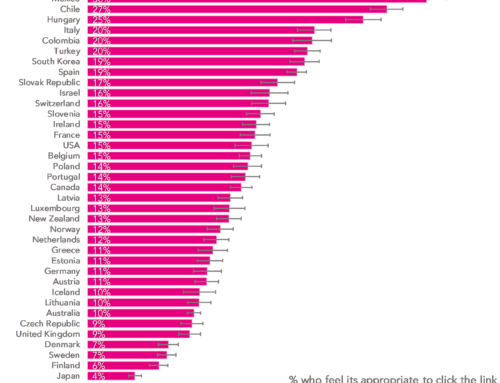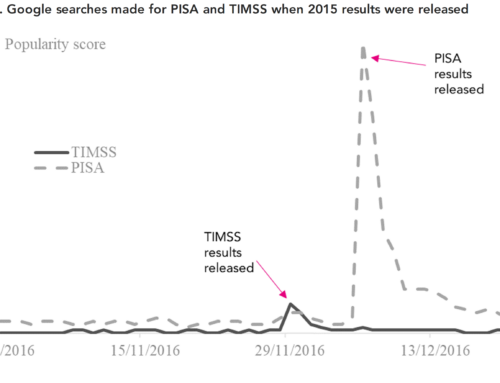When the reform to GCSEs was initially announced, under the watch of Michael Gove in 2014, the intention was to link performance on the new GCSE exams to the PISA test.
Now, as far as I am aware, this link between PISA and national examination standards has not been established. Instead we have the comparable outcomes policy [PDF] and the national reference test to ensure standards are comparable over time.
Yet the interesting question remains – how do the ‘currency’ of GCSE grades and PISA test scores translate?
GCSE grades linked to PISA
The latest data currently available to look into this issue comes from PISA 2015, with that cohort of pupils sitting their GCSEs in May/June 2016. This group were the last to be tested fully under the old GCSE regime using alphabetic grades. Nevertheless, we can convert these into approximate ‘new’ 9-1 GCSE grades.
The table below compares GCSE mathematics grades and average PISA maths scores. It illustrates how a GCSE C grade (which translates to a grade 4 or a low grade 5) on average is roughly equal to a score of 473 on the PISA mathematics test.
A score at this level is some way below the OECD average (490) and roughly equivalent to a lowly 42nd place in the international rankings.
This perhaps illustrates why the Department for Education tried to raise the bar when introducing reformed GCSEs. Leaving the expected standard at grade 4 or above (grade C or above in old money) would not be considered ambitious enough. Hence a new a “strong pass” was introduced at grade 5 or above to bring the expected standard more in line with the international average.
By way of illustration, the equivalent score for a B (somewhere between a 5 and a 6) was about 50 PISA points higher, at 521 – equivalent to the average score of South Korea in 7th position.
The table below performs the same comparison for PISA reading and GCSE English language grades. Now, we probably have to be a bit more careful here, given that there are some quite significant differences in what these two tests are measuring. Nevertheless, the same holds true as for maths.
Having GCSE grade C (grade 4 and the bottom end of 5) as the target is not particularly ambitious: it is equivalent to only 488 on the PISA test – again below the OECD average and equal to the reading skills of the average teenager in Latvia.
On the other hand, teenagers who achieve a GCSE grade B (somewhere between a 5 and a 6) have the same reading skills as teenagers in Singapore (the top-performing PISA country).
In my opinion, if England’s policymakers want to be ambitious, there should be one pass mark only and this should be set at grade 5. Others will disagree with me though, as in the short-term at least there will be some limit on how many pupils could achieve this standard even if Ofqual allows some year-on-year growth in attainment.
PISA 2018 offers the first opportunity to benchmark new GCSEs internationally
Of course, all the analysis presented above is based upon a cohort of pupils who took the old GCSEs, prior to some of the recent reforms. Data from PISA 2018 linked to the National Pupil Database will offer the first opportunity to benchmark the new, reformed GCSEs (including the 9-1 formation of the grades) internationally.
This, in my view, should be a priority for future work by the Department for Education, so we can better understand how education standards in England compare to other countries across the world.
Want to stay up-to-date with the latest research from FFT Education Datalab? Sign up to Datalab’s mailing list to get notifications about new blogposts, or to receive the team’s half-termly newsletter.








The comparisons are interesting, though not particularly meaningful given the doctrine of comparable outcomes. The average score on GCSE papers may vary over time, but the average grade achieved will not, unless there is some significant difference in a cohort, which is unlikely. That means that approximately the same proportion of students that get each grade over time will not change.
It is also most unfortunate to refer to “pass” grades. We work hard with students every day to prevent the sense of failure that they are likely to feel, if a grade less than 4 is their realistic expectation. To suggest that only a grade 5 or more counts condemns an even greater proportion of children to feel that they have failed, or that education has failed them. Fine to refer to 5+ as a “strong pass” or 4+ as a “good pass”, but to suggest that either 4 or 5 is a “pass” with no adjective is potentially very damaging.
Thanks for your comment. On the first point – that is what the NRT is for. So, despite comparable outcomes, it is now possible for grades to go up or down each year.
On the second point, I disagree. I think a lot of people find the idea of there being two pass marks confusing.
very interesting, thank you. Is the comparison of GCSE mathematics grades and average PISA maths scores calculated by literally averaging the (aged 15 in 2015) PISA maths score for students who attained each (aged 16 in 2016) GCSE grade, i.e. a student-level calculation?
Thanks Matt. Yes, it was a student level calculation!
This is very interesting, but becomes even more so if national IQs are included. Why wouldn’t you do this? My study of the CATs based Mossbourne Academy admissions system (Part 4 in my book ‘Learning Matters) reveals the issue.
Mossbourne had four quartile based admission bands
Band A – 110 & above
Band B – 100 – 109
Band C – 90 – 99
Band D – below 90
Mossbourne sets students for GCSE maths. It would be surprising if the CATs distribution in the four sets differed much from the admission bands.
But you couldn’t validly compare the quality of teaching in set 1 to that in set 4 from the raw results of any test, GCSE or PISA, could you?
This principle is the basis of my reworking of the 2015 PISA maths results, which has been endorsed by academics of international standing and has yet to be challenged.
https://rogertitcombelearningmatters.wordpress.com/2016/12/18/national-iqs-and-pisa-update/
These are the mean national IQs (with percentiles) for the countries listed in the article. These have been provided by Richard Lynn (see article for details and sources). While these data can be challenged for accuracy there is no doubt that significant differences on such a scale exist even though this fact may be a source of discomfort. The mean national IQ is given followed by the percentile and the corresponding Mossbourne Academy maths set
Singapore 109 (68th) set 2
South Korea 106 (66th) set 2
Israel 95 (39th) set 3
UAE 83 (12th) set 4
Georgia (not available)
Peru 85 (16th) set 4
Algeria (not available)
Dominican Republic 82 (12th) set 4
UK (PISA score 482) 100 (50th) set 2
US (PISA score 470) 98 (45th) set 3
The conclusions in my article still appear to be sound in that the performances of Singapore and South Korea are much less impressive when their high national IQs are taken into account and those of the UK and US are terrible however you look at them.
When you consider the GCSE column in the article it should not be surprising for students with CATs scores of 109 to get A/A* grades at GCSE
Hello! Interesting stuff, but….~!
(1) Where’s the underpinning methods / results / detail / research? (There’s no link to anything? A blog post alone isn’t necessarily that helpful for some people.)
(2) Isn’t PISA supposed to be non-curricula-based and focused on applied task and problem-solving, while GCSE exams are based on specific curricula? (I’m sure that you -can- do these comparisons, but whether they are meaningful is another question.)
(3) Stepping back a bit, there’s no critical reflection on different socio-cultural, economic, and other aspects of life across countries?
(4) I’m sorry if I’m missing something, but what’s the ultimate message or ‘take home point’ here?
Thanks Caleb.
The work was never written up as a paper. The reason was the very limited time that I had access to the data when doing this stuff just after the PISA 2015 results were released. But I am happy to answer any specific questions you have.
On point (2) – yes, that is what is claimed. But the PISA-GCSE correlation is actually very high. And, if you look at questions in some subjects (e.g. maths) I believe the comparisons are not unfair to make. Though I would agree more dubious for PISA reading to GCSE English.
On point (3) – fair point. But that would be another blog (or even a whole PhD!).
On (4) – I think the main message for me is that I believe it illustrates in many ways how the old C grade was actually pretty low.
Hi
Great thought provoking blog. I have a question regarding content of the curriculum. Last year the top marks in maths only achieved half the marks. From reading “Cleveland” it is my understanding that the highest performing PISA ‘nations’ have much narrower maths curricula. The idea is to ensure everyone gets to the baseline. So is a PISA score comparable to a GCSE grade?
Thanks Liam. Good question. I think it varies between subjects. I believe comparing PISA maths to GCSE maths is probably the fairest comparison (and the correlation is pretty high – about the same as the correlation between NRT scores and GCSE scores). I am more dubious for PISA reading to GCSE English comparisons.